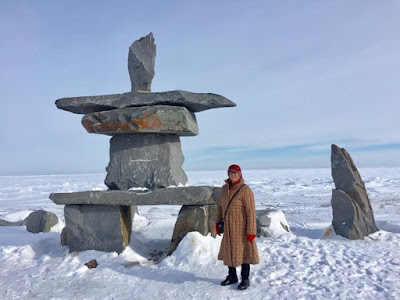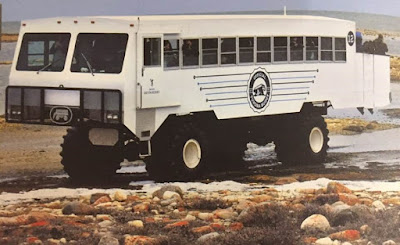In early March 2018, the NORTHERN LIGHTS
adventure started in Winnipeg, Manitoba.
This was the visit
stop en route to Churchill, Manitoba, CANADA, which is reputed to be one of the
best places on Earth to maximize one’s chance of seeing the northern lights at
their most active and most vivid. Churchill is located directly beneath the Van
Allen Belt, a layer of energy-charged particles that wraps the earth's polar
regions; the particles originate in solar flares. Then they are carried by
solar wind, and are trapped in Earth’s magnetic field; this is what creates the
phenomenon of the aurora borealis, aka THE NORTHERN LIGHTS. Churchill is
technically subarctic as it lies below the Arctic Circle. However, Churchill
will likely have an Arctic climate and feel, because it is geographically
located at the edge of the frozen expanse of Hudson Bay. I know it sounds
remote, but Churchill is actually easy to reach by air from Winnipeg, which is
the capital (and largest city) in Manitoba.
…………..
NOTES FROM BRIEF VISIT TO WINNIPEG ……………………………
This ice palace is built near the Esplanade Riel foot bridge at The
Forks, which is what the confluence of the Red River and the Assiniboine
River is called. For at least 6000 years, it was the meeting place of early
peoples in northern Manitoba, and continues to be a meeting place of everyone
who lives and passes through. In the background, you can see the top of the
beautiful foot bridge that crosses the river, and here, for my inquisitive
friends, is verification that I have an angel on my shoulder when I travel.
The INUKSHUK,
my favorite exhibit as I visited the Manitoba
Museum in Winnipeg today. Here’s
the exhibit explanation: Dispersed throughout the vast undulating terrain of
the Canadian Arctic are numerous stone figures and cairns which serve as a
testimony to the early and continuous occupation of the area by nomadic hunting
groups. These features are known as “Inukshuit”, an Inuit word meaning
“something acting in the capacity of man” or “something resembling a person”.
The inukshuk can be found standing alone, arranged in groupings, or aligned in
long rows extending for several miles in low lying areas, on prominent heights
of land, and along coastlines. Varying in size, complexity and location, these
structures were part of caribou hunting strategy, served as land and water
navigational aids, campsite markers, and were reminders of special occasions.
|
|
This INUKSHUK is about 12 feet tall. Above is
an Inuit artist’s illustration from the exhibit about how they are built...
Note the difference in footwear, from being
able to walk the somewhat snowy sidewalks of Winnipeg today in regular shoes,
to changing into the heavy high snowboots that will be required tomorrow in Churchill, Manitoba. The
distance is a little over 1000 miles as the crow flies, and the flight will
take 2 1/2 hours. Weather in Churchill hopefully will not include cloudy skies,
sInce that could make seeing the Northern Lights problematic…but it will be
COLD there on Hudson Bay, with the forecast hovering between 1 and 10 degrees
Fahrenheit!
The toe of my heavy snow boot is pointing at
the bottom of Hudson Bay, which is where Churchill is located.
The toe of my walking shoe is pointed toward
an orange blob, which is where Winnipeg, the capital of Manitoba, is located.
|
Churchill, Manitoba, our tour leader and Aurora
Borealis photo expert Mike Gere explained, is the place on earth where you have
an excellent chance to see nature’s most remarkable light show. It’s reputed to be one of the best places on
Earth to see the northern lights at their most active and most vivid. Churchill
is located directly beneath the Van Allen Belt, a layer of energy-charged
particles that wraps the earth's polar regions; the particles originate in
solar flares. Then they are carried by solar wind, and are trapped in Earth’s
magnetic field; this is what creates the phenomenon of the aurora borealis, aka
THE NORTHERN LIGHTS. Churchill is technically subarctic as it lies below the
Arctic Circle.
Weather! Darn it, cooperate! If I am going to
freeze my (fill in the blank)s off, I want to at least see the Aurora. Is that
too much to hope for? Well, if the weather station here in Churchill is any
indication, I guess so.
|
|
So what’s it like to be on the frozen shores of
Hudson Bay? Well, you can pose with an INUKSHUK,
or you can wonder about sailing these chilly waters when the ice breaks in a
few months.
Today, Pippi Longstocking (the strongest girl
in the world) and I went to visit the polar
bear holding facility here in Churchill, Manitoba. Why would anybody want
to “hold” a polar bear, we wondered, since they are very big and very strong
and very fierce. We found out that this is a different kind of hold, and here is how it works: if I am a
polar bear who wants to walk around town regardless of the police honking at me
and trying to change my mind, then the wildlife folks are going to shoot me in
the butt with a tranquilizer and put me into my own comfy private cage inside
this building. I won’t be able to see the other bears because that will stress
me out! Then the wildlife folks are going to give me a free ride out of town
when there is more food for me to find on the tundra. Also if I’ve been a bad
bear before, I’ll get some holding time.
Sometimes bears are attracted by a burlap sack that’s been saturated with seal slurry (yum!) and walk into this cement kinda/cave that the wildlife people put not far outside downtown Churchill. Again the shot in the butt and again some holding time
We rode across the
frozen Churchill River in the Tundra
Buggy ™ to see our first Northern Light sighting! A “mild”
Aurora according to photographer and tour guide Mike Gere. This is his photo, taken near the mobile Tundra Lodge on the edge of frozen Hudson Bay where we keep
warm as we keep night watch.
Photo by Mike Gere
You can go to this website (aurora-service.org)
to get a prediction of the likely Northern Light Activity
These Tundra Buggies
run on construction-truck tires and can seat 40 people inside. How big is the tundra buggy? Well, I’m pointing to the 8 foot mark. A full grown adult polar bear can reach to
the bottom of the window, and that’s about 16 feet. Don’t dangle your scarf or camera case out of
that window if you are going to visit polar bears!
We took an excursion to the Churchill Rocket Research Range, a
facility was used by Canada and the United States beginning in 1954 for
sub-orbital launches of sounding rockets to study the upper atmosphere.
No longer in use, the area now hosts the Churchill Northern Studies Center,
which is situated at the meeting of 3 biomes— marine, boreal forest and tundra.
They offer an amazing array of school group, family and adult study tours and
adventures to learn about the Aurora, polar bears, belugas and more. Check it
out
https://www.churchillscience.ca/events/
https://www.churchillscience.ca/events/
This is the pop-up gourmet restaurant called Churchill:RAW, in place for only 9 days
in the middle of the thick stone walls of the mustering area at the Prince of Wales Fort National Historic Site.
To get there, we went in the Tundra Buggy across the frozen Churchill River. We
were escorted in by our bear lookout guard and had an intro lecture by a Parks
Canada interpretive guide dressed in period (1720s) costume. Thrilling!
Who is up for a dogsled ride in the subarctic tundra?
Me! Wapsusk Adventures took us two-at-a-time for a great mile run.
I was wondering why the ride on the Tundra
Buggy was so bumpy and why the driver had to swerve so much, but now I know.:
those bumps everywhere are called ice
hummocks. Some are taller than 15 feet. They are caused when ice rises
above the general level of an ice field (like frozen Hudson Bay, where we are
driving). Ice rises when there is a little crack from the intense pressure as
ice hardens and water wells up from the river or bay. More cracks, more water,
more height.” Sometimes the hummocks even look like ice forts!
Pippi Longstocking,
the strongest girl in the world, was sad to discover that there were no snowshoes in her size so she couldn’t
join the group as they walked into the boreal forest. And she was also not old
enough to join in shots of Casamigos tequila afterwards...
Our final night in
Churchill, we were treated to this display of the Northern lights….
Churchill is also
known as the Polar Bear Capital of the
World. Yes, they do cross the road!
Below is a photo by National Geographic photographer JAD Davenport (who I met on the plane from Denver to Winnipeg) of two sparring adult male Polar bears. Although the mothers and cubs start emerging from their gestation dens in late March to scamper across the ice to reach the ice floes forming in Hudson Bay and the Churchill River – in an attempt to evade the wolves that are predators of the cubs – the true heart of the viewing season is in October and November. Maybe I’ll go back. But, brrrr, it will be cold even then!
 |
| photo by Mike Gere |
Below is a photo by National Geographic photographer JAD Davenport (who I met on the plane from Denver to Winnipeg) of two sparring adult male Polar bears. Although the mothers and cubs start emerging from their gestation dens in late March to scamper across the ice to reach the ice floes forming in Hudson Bay and the Churchill River – in an attempt to evade the wolves that are predators of the cubs – the true heart of the viewing season is in October and November. Maybe I’ll go back. But, brrrr, it will be cold even then!
Wolves stalking Polar
Bear mothers and cubs…photo by JAD Davenport.
His commentary: “These wolves
have never seen people before. The last two mornings one has approached us and
sniffed our komatiks (sleds) while we’re on them. I could see the frost on his
eyelashes and hear him breathing. He’s not afraid, just really curious. And
huge, probably 120 pounds.”





























